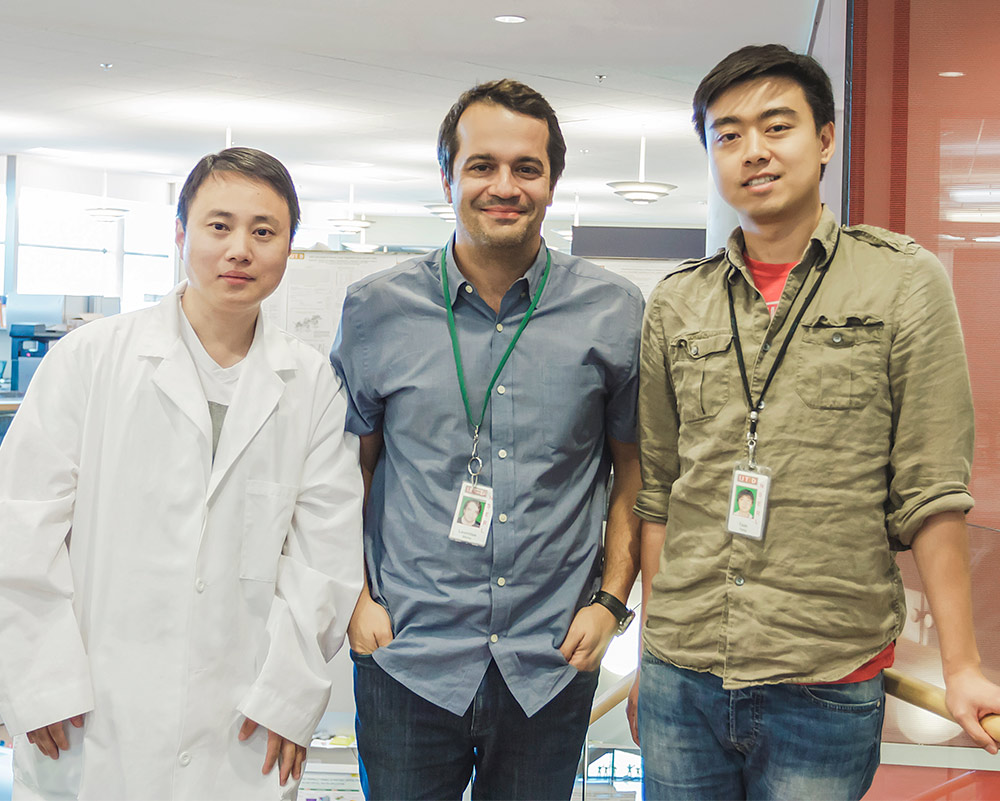
The team included postdoctoral researcher Dr. Yi Li, associate professor of bioengineering Dr. Leonidas Bleris and research assistant Taek Kang. Other members not pictured are research assistant Dr. Richard Moore MS'11 PhD'15 and Dr. Eduardo Sontag, a professor of mathematics at Rutgers University.
Bioengineers from the Erik Jonsson School of Engineering and Computer Science at UT Dallas have shed light on the mysteries of biological pathways.
The findings, which were published in the journal Proceedings of the National Academy of Sciences (PNAS), could affect a wide range of applications relevant to public health and therapeutics.
In the article, “Discriminating Direct and Indirect Connectivities in Biological Networks,” the team of researchers shows that the integration of engineering, mathematics and synthetic biology can lead to new insights on the properties of biological networks.
The team included Dr. Leonidas Bleris, associate professor of bioengineering; research assistants Taek Kang and Dr. Richard Moore MS’11 PhD’15; postdoctoral researcher Dr. Yi Li; and Dr. Eduardo Sontag, a professor of mathematics at Rutgers University.
The work was supported by grants from the National Institutes of Health and the National Science Foundation.
“You can think of pathways as the internal wiring of your cells, a network that is responsible for processing external and internal signals and making critical decisions,” said Bleris, who is the senior author on the paper.
“If there is something wrong with a gene, then it will not only lose its normal function but also affect all its connections,” Bleris said. “Therefore, understanding biological networks and how information travels in pathways is important toward identifying the cause of diseases and designing effective therapeutics.”
“Understanding biological networks and how information travels in pathways is important toward identifying the cause of diseases and designing effective therapeutics.”
Dr. Leonidas Bleris,
associate professor of bioengineering
Despite advances in quality and quantity of available data and computing resources, deciphering between direct and indirect connections in networks is still challenging.
“Understanding biological pathways usually requires experiments, data processing and theoretical analysis,” Bleris said. “As an example, if we consider three genes — where A is activating B and B is activating C — then algorithms will typically predict an activating connection from A to C, even though there is no direct biological interaction. There are still persistent errors that justify the urgent need for novel approaches and insights.”
In Bleris’ Systems and Synthetic Biology Research Lab, researchers devised a new method to probe direct and indirect connections in pathways. The team used engineered synthetic networks embedded in human cells that emulate, but are physically distinct from, biological pathways that could be used as a “ground truth” for characterization techniques and theory development. Using these benchmark pathways, they discovered a solution to a longstanding reverse engineering problem.
“Biological reverse engineering is a community-wide effort by scientists around the world,” research assistant Taek Kang said. “I hope our study can help others in validating and refining their own reverse engineering method. In particular, there are widespread efforts to implement individualized therapies based on one’s genetic makeup, and the ability to accurately recapture or validate the gene network behind the disease is a crucial step in this process.”
The researchers hope that the findings will be applied to help understand the mechanisms of complex human diseases, including cancer, and to develop targeted therapies.
“Developing automated and validated methodologies for unraveling the properties of biomolecular networks in human cells is one of the central challenges to life scientists and engineers,” Bleris said.
In 2014, Bleris helped create a novel gene-delivery system that temporarily transports a gene into a cell, inventing a potential new gene-therapy strategy for treating disease. He was lead author of a study that described the system in the journal Nucleic Acids Research.
Bleris is also a recipient of a 2014 National Science Foundation Faculty Early Career Development (CAREER) Award. He joined the Jonsson School in 2009 after a postdoctoral appointment at Harvard University. He received a PhD from Lehigh University in 2005, and a diploma in electrical and computer engineering from Aristotle University in Greece in 2000.